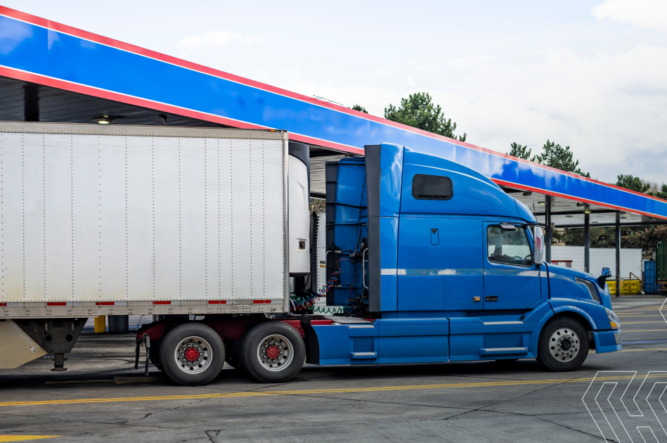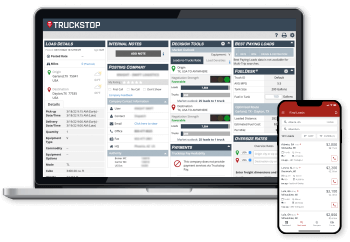7 Practical Ways to Improve Trucking Fuel Economy

What are you waiting for?
Make more money starting now.
Almost every truck driver knows a trick to save fuel and increase the average miles per gallon ratio. Some methods are tried and true while others work for some, but not others. But conserving fuel is an important part of being a carrier and increasing your bottom line.
Fuel is the top expense when it comes to driving a truck. And while it’s considered a “fixed” expense, meaning it can’t be controlled, there are actions you can take to minimize your consumption to increase your profitability.
Here are 7 practical ways to improve your fuel economy.
1. Control Your Speed
Increased speed limits on the highway allow truck drivers to reach their destination in a shorter time period. But a faster trip may actual be costing you more in fuel.
Your fuel mileage decreases once your truck passes its optimal speed around 60 mph. Exceeding this speed wastes fuel—and money. Even a slight decrease in your highway driving speed can significantly reduce your fuel consumption, and only adds a few minutes to your travel time.
According to the Department of Energy, every five miles per hour (MPH) you drive above 60 MPH is like paying an additional 24 cents per gallon for fuel due to more wind and rolling resistance. On average, trucks will see the best fuel efficiency between 55 and 60 mph.
Higher speeds also cause more wear and tear on engines and tires, costing you additional maintenance and down time.
2. Find the RMP Sweet Spot
Finding the RPM “sweet spot” is the most efficient way to maximize your fuel. Making your engine work harder to drive at a certain speed causes you to burn fuel faster. The trick is to use torque, not horsepower, to pull your load. Torque helps you sustain your speed without overworking the engine.
A good sweet spot is around 1250 – 1350 RPM. Every truck engine varies, so check your owner’s manual or your truck dealer to understand your peak horsepower and torque at a specific RPM.
Remember, modern engines are built for high torque at low RPMs. It’s better to shift to the next highest gear while still at a low RPM than waiting for the engine to run up to a high RPM.
Other ways to get more from your gears:
- Make sure you use progressive shifting techniques and shift efficiently.
- Use a combination of braking and shifting to slow down.
- Maintain as high a gear as possible.
- Stay 200-300 rpm below the governor at cruise.
3. Reduce Drag with Aerodynamics
Your truck’s aerodynamics is particularly important when traveling at high speeds for long distances. Minimizing aerodynamics drag contributes to 50% of overall fuel economy making it worth the investment to equip your rig accordingly.
Look for aerodynamic designs and devices that reduce the gap between the truck and the trailer, limit airflow under the truck, and allow circulation through slotted mud flaps to minimize fuel consumption.
This may include:
- Chassis skirts
- Roof fairings
- Fifth wheel placement
- Boat tails
- Gap fairings
4. Purchase Low-Rolling Resistance Tires
Low-rolling resistance tires are a great improvement to a truck – both in wear on the tire and fuel efficiency. For every 3% rolling resistance improvement, you will likely see an increase of 1% in fuel efficiency and enhanced performance.
Single-wide tires can improve fuel efficiency by 4-8% and are lighter in weight. Single-wide tires also have lower maintenance costs with less downtime, service time, and brake wear.
Tire inflation also impacts fuel consumption. Every 10 psi under-inflation increases fuel consumption .5%. Automatic tire inflation systems or a stringent tire maintenance program ensure tires are properly inflated and can increase fuel efficiency.
Making an informed tire purchase gives you significant fuel economy gains. Look beyond the purchase price to consider tire grip, tread life, and rolling resistance. Investing in tires with a long life make their true cost of ownership lower than you think.
5. Brake Smarter
Every time you brake harshly or more frequently than you should, you increase your truck’s fuel consumption, reducing your truck’s fuel mileage significantly. Braking causes your transmission to downshift or manually regain the momentum you lost when you braked. The lower the gear you are in, the faster your engine’s revolutions have to be. The higher your RPMs, the more fuel you waste and the harder you make it on your vehicle to haul your cargo.
Keep a steady speed to avoid quick decelerations and excessive burning of fuel. Brake smartly by going at a consistent pace and leaving plenty of room for the vehicle ahead of you.
6. Use the Right Lubricants
Using the right lubricants requires minimal investment but can yield noticeable fuel efficiency.
Low-viscosity lubricants can improve fuel economy by about 2%, while the new formulations have been known to increase efficiency by up to 4%. Switching from a SAE 15W-40 grade to a SAE 10W-30 grade is a great way to save on fuel in the long run. Since engines can vary, make sure to speak to your mechanic to find the best lubricant for your truck.
7. Plan Your Routes
Route planning can help you avoid the temptation of speeding to meet a delivery deadline. If you plan your routes in advance, you’ll avoid tight time constraints that will entice you to increase your speed. It also helps you map out the most direct route so you can avoid tolls and unnecessary detours.
Be sure to factor in the number of off- and on-ramps as well. Your truck burns more fuel on an on-ramp as it works to get up to speed. If you can avoid them to get to a fuel stop, all the better for your fuel efficiency
Simplify Fuel Management with Fuel Desk
Truckstop Fuel Desk, a feature of the Truckstop Load Board, includes practical routing directions to save you miles and shows you the best fuel stops. Learn more about how Fuel Desk can help save you money.

Find out how our platform gives you the visibility you need to get more done.
Get helpful content delivered to your inbox.
Schedule a demo.
Find out how our platform gives you the visibility you need to get more done.





